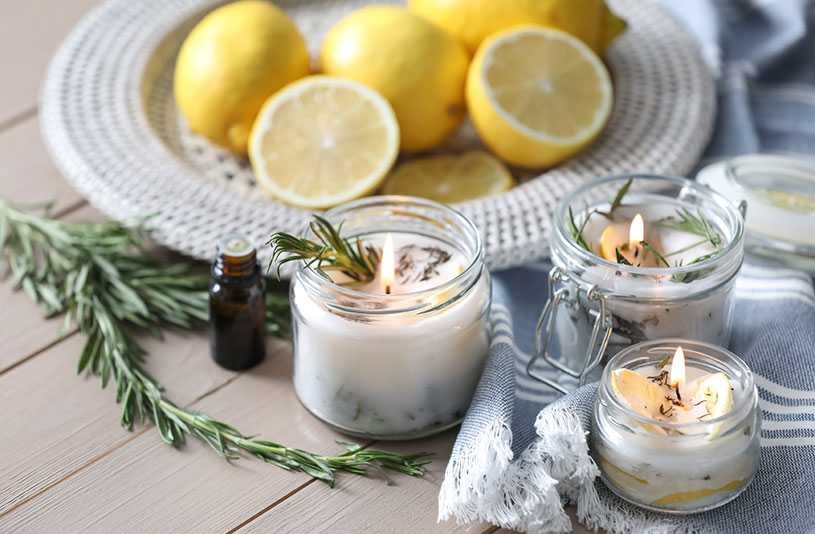Start with the right materials to explore the science and art of candle-making. This list contains essential supplies for making candles.
1. Candle Wax
This is a vital component of candle-making, as it keeps your wick lit. It should not melt at higher temperatures and must remain intact under normal conditions. The candle wax must be water-resistant, odorless, and low in toxicity.
The right wax for candles is important because it considers texture, color, and scent. There are many types of candle wax available.
- Beeswax: This type of wax is made by honeybees. Honey production gives it a sweet, natural scent. It melts faster than other candle waxes, and it burns cleanly without any dust or ash. This wax can be difficult to use if you are a beginner in candle-making.
- Paraffin Wax: This is the most common and affordable candle wax. It can be easily scented and colored, but it will likely have black soot on the container and wick. You can also get it in different blends and melting points.
- Soy Wax: Made from soybean oil, this wax can also be blended with other waxes to achieve different melting points. It burns cleaner than paraffin wax and will require more dye to get the desired color. Translucent candles are made by using gel wax. It is made up of mineral oil and polymer resin. This wax is not strong enough to be left alone so it is best to keep it in containers.
- Palm Wax: This natural candle wax is made of palm oil and creates a feathered or crystallized look on the surface.
2. Candle Wicks
This is a small strip of material that helps to keep your candles lit. This item is as important as wax as candles will not light without it. After you have burned your wick, your wax will begin to melt.
The right wick size and thickness will ensure that your candle burns properly. A wick that is too small or too big will not melt the wax completely. Too many wicks will produce lots of smoke. Also, consider the shape and size of your container as well as what wax type and additives you will use.
Wicks, like candle wax, come in many forms and materials.
- Cored: If you plan to place your candles into votives or containers, a cored Wick would work well. It is made of paper, zinc, and cotton, which makes it rigid.
- Square: This wick has square tips and corners. This wick is suitable for use in taper candles, beeswax, and pillars. While it is burning, its tip bends slightly.
- Flat: This candlewick is the most popular and best for a freestanding, pillar, and taper candles. It is made from small threads that are either knitted or braided together to form a bundle. This wick can be trimmed and curled on its own after it has been burned.
- Specialty Wick: For unique candles, such as those used in oil lamps or insect repellents, you will need to use special wicks.
3. Wick Holder
Your wick should be in place when you pour the candle wax into the mold or container. To ensure your wick doesn’t get lost in your wax, use a holder
A wick holder is not necessary if you are using pre-waxed or paraffin-dipped wicks.
4. Candle Molds
A candle mold is another important supply for Candle Making. With its unique and intriguing shapes, you can make truly original candles.
It is usually made from three types of materials: silicone, metal, and plastic. You can make many shapes with silicone or plastic, but a metal mold will give you the best result.
Some waxes can be used to make candle molds. Paraffin and beeswax are your best choices.
You can also use things in your home, such as empty milk cartons and muffin tins to make candle molds.
5. Wicking Needle
A wicking needle will take the strain out of threading your candle wick through a mold. This is especially useful when threading a large candle wick through small holes.
6. Melting Pot
Your wax should never be heated directly when it is melted on the stove. To melt your candle wax perfectly, use a melting pan.
7. Thermometer
You must carefully monitor the candle wax when you make it. To check the temperature, you can either use an infrared gun or a candle thermometer.
Make sure your wax is not too hot. Other supplies, such as perfume oils, must be added at a specific temperature.
8. Candle Dye
This item can be used to add color to candles. It is important to ensure that the item will work in your candle wax. Some wax types like soy wax may require more color application.
There are three types of candle dyes: liquid, chips, and blocks. Because it doesn’t have to be dissolved, a liquid dye is the easiest to use. It can be used in the mixing of colors. It can be used in the making of dye chips. When applied to soy wax it creates light and pastel shades, and paraffin produces light and dark shades.
Dye blocks, on the other hand, produce vivid and dark colors in soy wax. This can be used to color large quantities of paraffin.

